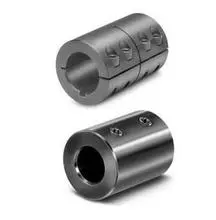Application of the Couplings
Rigid coupling: rigid coupling has no ability to compensate relative deviation of the two axes as well as buffer shock absorption performance, but the structure is simple and the price is cheap. Only under the conditions that load is steady, speed is stable, minimal relative offset can be guaranteed by two league axes, can choose rigid couplings.
Parallel coupling and threaded coupling: small volume, high precision, light weight, simple structure, forming elastomer through cutting with good elasticity, and can well compensate axial deviation of machinery in the operation process as well as radial deviation, angle deviation and integrated deviation, generally used in connection of encoder.
Plum coupling and oldham coupling: small volume, high precision, light weight and simple structure. Elastic plum coupling can compensate large radial, angular and axial deviation with simple structure, oil resistance and electrical insulation. But because it is non-metallic, elastic element strength is low, and is not resistance to high temperature and low temperature, suitable for high speed, light load and room temperature conditions, being widely used in jointing between stepper motor and servo motor.
Diaphragm coupling: elastic membrane has absorption deviation, besides good buffer shock absorption performance, it has large carrying capacity and can be used for conditions where speed and load changes drastically and high or low temperatures. As for small diaphragm coupling, because of its small size, high precision, good elasticity, simple structure, convenient installation, it is widely used in connection of stepping motor and servo motor.
At last, the structure characteristics of elastic coupling of high precision is that there exists an insurance link, it can only carry limited load, when the limited load surpasses advance limited load, insurance link will change, blocking movement and power transmission to protect the rest of the machine from damage, namely the security protection.

